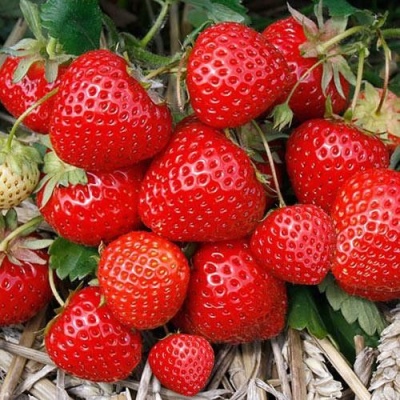
- Authors: Research East Malling, UK
- Name synonyms: Elegance, EM1276
- Taste: sweet
- The size: large
- Weight: 25 g
- Yield rate: high
- Ripening terms: medium
- Appointment: fresh consumption
- Description of the bush: tall, strong, erect
- Berry color: bright orange or red
Elegance, also called Elegance and EM1276, is sought after by many gardeners for its characteristics. Strawberries are unpretentious, resistant to various diseases and capable of producing a high yield. It has delicious and beautiful berries.
Description of the variety
The bushes are tall and strong, erect, about 30 cm high. The leaves are bright green, large, most often with 5 lobes. The flowers are small, white in color.
Ripening terms
Strawberries have an average ripening period, flowering in May, and harvesting in mid-June. The fruiting period is slightly extended - June and August. It depends on the climatic conditions in which the culture grows.
Yield
The variety gives a large, stable yield, therefore, its yield is considered high.
Berries and their taste
The color of the fruit is bright orange or red. Strawberries have a uniform conical shape and large size, weighing about 25 g. There is a lot of juice in the pulp, it is fleshy and rather sweet. Gardeners practically do not meet non-standard and crooked berries, all fruits are one-dimensional. The skin is shiny, dense, has depressed achenes.
Strawberries have a high marketability and good transportability, do not lose their attractive presentation during transportation both for short and long distances, they will not be damaged and will not flow. The purpose of the berries is fresh consumption, but some prepare blanks from it for the winter and actively use it to prepare a variety of dishes.
Growing features
The variety is planted from April to October both in open ground and in greenhouses. The recommended landing distance is 15-20 cm.




Site selection and soil preparation
It is necessary to select an area that meets the following requirements:
well lit by the rays of the sun;
protected from the north wind;
the soil has a flat surface;
the depth of the groundwater is up to 1 m.
You can plant strawberries on any type of soil, but slightly acidic and neutral soils are the best option. The land should be prepared before the crop is to be planted. If it is planted in the spring, the soil must be processed in the fall. If planting is planned in the fall, the beds are prepared several weeks before the process.
The soil is well dug with a pitchfork, weeds are removed from it and its root systems are selected. After that, mineral and organic fertilizers are applied:
10 kg of humus;
200 g of ash;
40-45 g of superphosphate.
After preparing the soil, you should wait a few weeks, let it settle.

Pollination
Elegance is a self-pollinating variety and therefore does not require pollinators around it.
Top dressing
Strawberries should be fed several times per season.
The first top dressing is applied in the spring, which helps to stimulate active foliage growth. For this, fertilizers are used, which contain nitrogen (infusion of mullein, chicken droppings or a solution with the addition of urea).
The second time the strawberries are fed before the flowering period. Potassium, phosphorus, boron and magnesium should be used. It is better to use complex fertilizers.
Before the cold weather, the variety needs nutrition, so you need to apply mineral fertilizers. Any substance that does not contain nitrogen is suitable.

One of the important techniques in strawberry care is feeding. Regular fertilization guarantees a rich harvest. There are several different ways to feed strawberries, and each of them is designed for a specific period of plant development. During flowering, fruiting and after it, feeding should be different.
Frost resistance and the need for shelter
The culture is able to withstand frosts down to –17 degrees. Strawberries are hardy, but in cold regions it is necessary to cover them for the winter so that the plant does not freeze. A layer of mulch made from straw or spruce needles is used. Some gardeners use agrofibre, securing the material with arcs.

Diseases and pests
Elegance is highly resistant to diseases and insects. The variety is practically not affected by late blight and verticillosis, but sometimes it can suffer from powdery mildew. For the prevention of diseases and injuries by dangerous insects, it is necessary to treat plants with biological preparations (Fitoverm, Fitosporin) before the flowering period and after fruiting.
And you can also use folk remedies.
Garlic, marigolds, onions and marigolds are planted near the culture. These plants are good at repelling pests.
On the soil where strawberries grow, you can sprinkle mustard powder or tobacco dust.
The bushes are treated with a solution of garlic arrows (500-600 g arrows per bucket of water).

Strawberries are often subject to many dangerous diseases that can seriously undermine their condition.Among the most common are powdery mildew, gray mold, brown spot, anthracnose, and verticillosis. Before buying a variety, you need to inquire about its disease resistance.
Reproduction
The whiskers released by the plants are enough for the breeding of the variety.



















































































